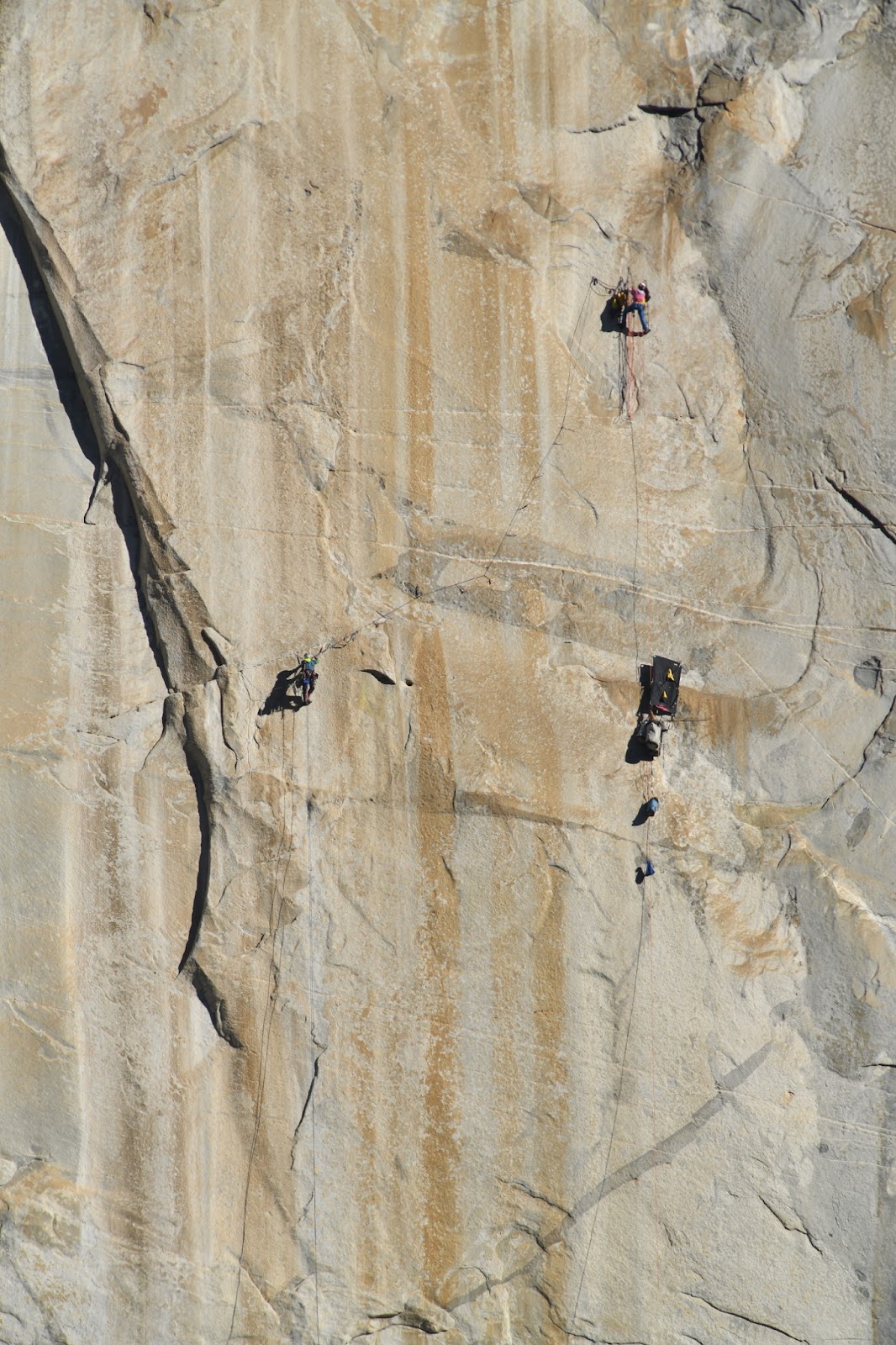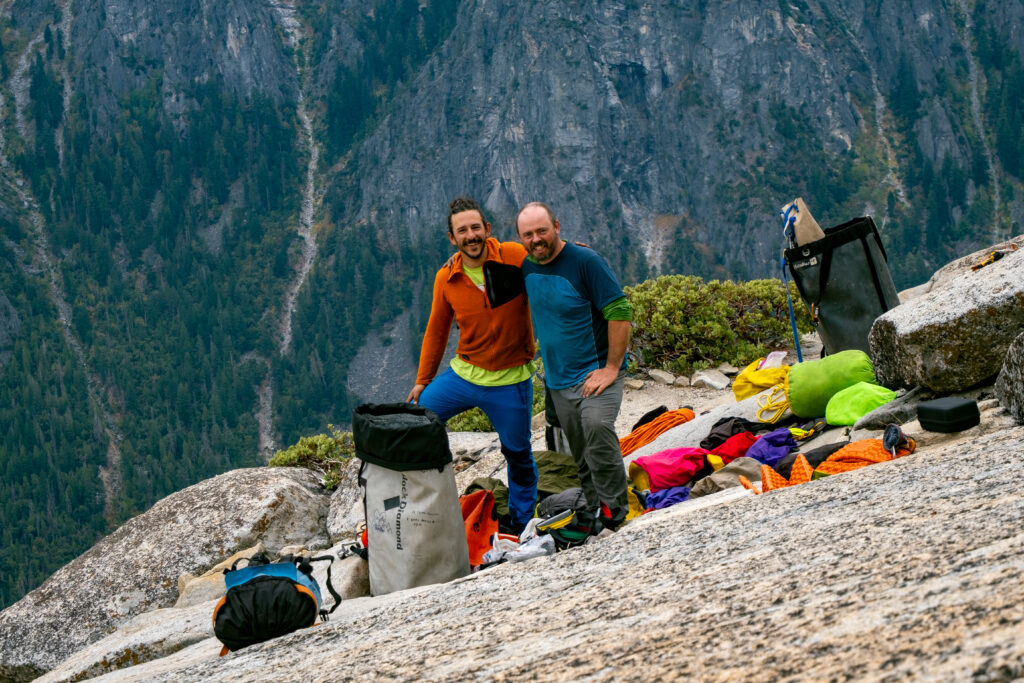“Are you cold?”. “I’m fine”, I say, shaking. I can’t feel my hands. I’m wet to the bone. Uncoiling the rope provides a little warmth and allows me to focus on something. Andy tells me he will go first. We had just down-climbed runout slabs under pouring rain. The consequences of a fall would be tomahawking your way home a few hundred meters. At least it would be quick. We are on the east ledges of El Capitan, Yosemite. I give him the end of the rope. How you deal with this end is crucial and makes for the first cause of death in the mountains. Rappel accident. To be safe, one must close the loop, keep the system in control. In those conditions, becoming one more entry in « Accidents in North American Climbing » would be quite easy. When exhausted, nearly hypothermic and wet, cutting corners is tempting. Andy literally wrote the book about rappels: Down, a 400 pages monument about how to get down from a mountain as safely as possible. During my climbing apprenticeship, I have read every page of this bible, and nearly every other book written by Andy. Paper torn, wet, covered in moss and dirt, I learned so much from those pages. Everything boils down to now. Giving a rope end to Andy Kirkpatrick. What will happen? Will he just throw it carelessly down the cliff, open, empty, knotless? It’s easy to speak, but what really defines someone is their actions. This is what matters.
We just spent 7 days climbing Native Son, a hard A4 route, wildly overhanging, technical, thin, and traversing. It took me a few days before letting go of the ground. Committing is scary. It’s like letting go of the harbor when you go for a long sail, tells me Andy while I’m looking down, longing for some horizontal safety. It’s easier to go back. Our first days were spent doing the crux of the route, knowing each other, creating first shared memories on which we will be able to build upon later, understanding what drives the other, what risk is ok for them, what is not. Becoming a team. It’s pretty safe to say that a serious A4 route, with demanding pitches, both by their technicality and their fall potential is a funny place to build a relationship with someone. Trial by fire, make or break — we made it. The French man had Yorkshire tea with milk everyday.

The only thing that really broke down on the wall was the fabric of the portaledge, which ripped while I was belaying Andy. Thankfully, his pitch was steep, hard, and time consuming, and after two hours of no hand belay, I had sewed everything back together. I even had time to take a nap! Two days later, day five out of seven, I am entering the Golden Finger of Fate. A massive tower that runs up El Cap for two rope lengths. I’m scared. It’s wide, steep, and detached. You can see from one side to the other and it’s puzzling to understand how it’s hanging there. ‘’Please, stay attached.’’ I tell myself. This pitch is a rite of passage. A full body experience. Once inside the squeeze, you can’t fully inhale or turn your head. Exhale, inch your way up, inhale to lock in. Breathe. Keep going. It took me more than an hour to make my way up two meters, edging between anger and panic. The overhanging squeeze tries to eat you and spit you out at the same time. The whole experience is soul crushing.
Fast forward two days later, I’m now belaying one pitch from the top while Andy disappears on the final slabs. It’s windy, and clouds are gathering. The mood is light, and we are both excited to get out of here. For the first time on the route, I make a mistake: I forget to remove the backup from the bags before freeing them. A misstep quickly fixed, but that reminds me that it’s not over and that summit fever is real. Temperatures are dropping quickly, I hope he’ll make it up there before the rain. An hour later, the bags and I reach the summit. We are dizzy on flat grounds, but deeply happy, although we both know that the worst is in front of us.
Down we go with two massive haul bags each. We’ll have to do multiple carries, going over all the east ledges descent twice in short hundred-meter sections. We try to stop on big rocks so we don’t have to lift the bags from the ground and risk hurting our backs. The terrain is jagged and steep, a real no fall zone, sometimes hugging the 700 meters drop by less than a meter. Ravens are watching, probably mocking my inability to move smoothly and my fear. Everything will be better after the rappels but we need to get there before the rain intensifies. The bags are excruciatingly heavy and I can feel my leg muscles tearing up on every step. Each big step down a rock is an opportunity to get sent into a glorious frontflip by the massive loads we are carrying. Any patch of gravel or sand is a menace to our precious balance and safety. Hiking up to the next bag is a rest, and the second descent always seems to go faster.
I’m looking up. Andy is not here yet and the rain is now seriously building up. The rock is slippery and proper waterfalls are pounding down the edges of the slabs. I need to get to the ropes quickly before it gets worse. I focus deeply, and name each step for someone I love: Valérie, Oscar, Dad, Mom, Simon, Friends. I stop, recollect, breathe. “Keep going and don’t trip” I’m saying to myself. “Focus”. There is this one step in the middle of the slabs, the crux. It’s probably 5.2. You wouldn’t even think about it with rock shoes and fair weather, but now, here I am, with a 35kg bag on my back, blown out shoes, water running down everything, trying to understand fifth class terrain beta. Match feet on this edge, right hand there. Single leg down squat to this patch of grass. It’s easy to ignore the water dripping along my neck all the way to my shoes while moving, but when I stop, it takes no time for me to realize everything I’m wearing is soaked. I’m very conscious that the hypothermia timer has now started.
The fixed rappel rope is damaged. We would need to do complex manipulations to pass the problematic sections. In better conditions, it would be a matter of minutes, but we both know we don’t have much margin now. Andy tells me he’ll leave his new rope there. I deeply appreciate the nylon sacrifice, but I don’t say much, focusing on my own survival. « I think I’ll be cold soon, Andy ». My teeth are now chattering. I give him the end of the rope. We look at it and we exchange a look. He ties an overhand knot and clips it to his belay loop with a locking carabiner. The loop is closed.
